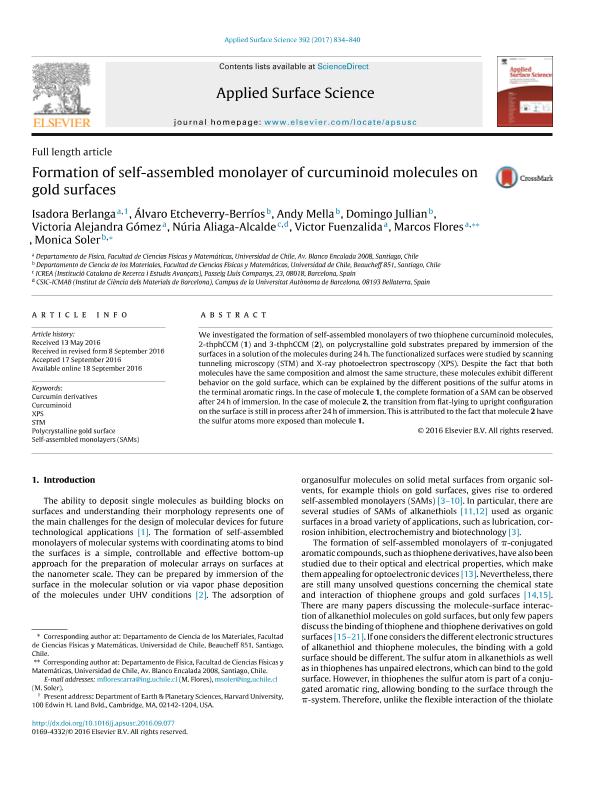Mostrar el registro sencillo del ítem
dc.contributor.author
Berlanga, Isadora
dc.contributor.author
Etcheverry Berríos, Álvaro
dc.contributor.author
Mella, Andy
dc.contributor.author
Jullian, Domingo
dc.contributor.author
Gómez Andrade, Victoria Alejandra

dc.contributor.author
Aliaga-Alcalde, Núria
dc.contributor.author
Fuenzalida, Victor
dc.contributor.author
Flores, Marcos
dc.contributor.author
Soler, Monica
dc.date.available
2019-10-17T20:50:30Z
dc.date.issued
2017-01
dc.identifier.citation
Berlanga, Isadora; Etcheverry Berríos, Álvaro; Mella, Andy; Jullian, Domingo; Gómez Andrade, Victoria Alejandra; et al.; Formation of self-assembled monolayer of curcuminoid molecules on gold surfaces; Elsevier Science; Applied Surface Science; 392; 1-2017; 834-840
dc.identifier.issn
0169-4332
dc.identifier.uri
http://hdl.handle.net/11336/86214
dc.description.abstract
We investigated the formation of self-assembled monolayers of two thiophene curcuminoid molecules, 2-thphCCM (1) and 3-thphCCM (2), on polycrystalline gold substrates prepared by immersion of the surfaces in a solution of the molecules during 24 h. The functionalized surfaces were studied by scanning tunneling microscopy (STM) and X-ray photoelectron spectroscopy (XPS). Despite the fact that both molecules have the same composition and almost the same structure, these molecules exhibit different behavior on the gold surface, which can be explained by the different positions of the sulfur atoms in the terminal aromatic rings. In the case of molecule 1, the complete formation of a SAM can be observed after 24 h of immersion. In the case of molecule 2, the transition from flat-lying to upright configuration on the surface is still in process after 24 h of immersion. This is attributed to the fact that molecule 2 have the sulfur atoms more exposed than molecule 1.
dc.format
application/pdf
dc.language.iso
eng
dc.publisher
Elsevier Science

dc.rights
info:eu-repo/semantics/openAccess
dc.rights.uri
https://creativecommons.org/licenses/by-nc-sa/2.5/ar/
dc.subject
CURCUMIN DERIVATIVES
dc.subject
CURCUMINOID
dc.subject
POLYCRYSTALLINE GOLD SURFACE
dc.subject
SELF-ASSEMBLED MONOLAYERS (SAMS)
dc.subject
STM
dc.subject
XPS
dc.subject.classification
Nano-materiales

dc.subject.classification
Nanotecnología

dc.subject.classification
INGENIERÍAS Y TECNOLOGÍAS

dc.title
Formation of self-assembled monolayer of curcuminoid molecules on gold surfaces
dc.type
info:eu-repo/semantics/article
dc.type
info:ar-repo/semantics/artículo
dc.type
info:eu-repo/semantics/publishedVersion
dc.date.updated
2019-10-15T13:23:08Z
dc.journal.volume
392
dc.journal.pagination
834-840
dc.journal.pais
Países Bajos

dc.journal.ciudad
Amsterdam
dc.description.fil
Fil: Berlanga, Isadora. Universidad de Chile; Chile
dc.description.fil
Fil: Etcheverry Berríos, Álvaro. Universidad de Chile; Chile
dc.description.fil
Fil: Mella, Andy. Universidad de Chile; Chile
dc.description.fil
Fil: Jullian, Domingo. Universidad de Chile; Chile
dc.description.fil
Fil: Gómez Andrade, Victoria Alejandra. Consejo Nacional de Investigaciones Científicas y Técnicas; Argentina. Universidad de Chile; Chile
dc.description.fil
Fil: Aliaga-Alcalde, Núria. Institució Catalana de Recerca i Estudis Avancats; España. Universitat Autònoma de Barcelona; España
dc.description.fil
Fil: Fuenzalida, Victor. Universidad de Chile; Chile
dc.description.fil
Fil: Flores, Marcos. Universidad de Chile; Chile
dc.description.fil
Fil: Soler, Monica. Universidad de Chile; Chile
dc.journal.title
Applied Surface Science

dc.relation.alternativeid
info:eu-repo/semantics/altIdentifier/doi/http://dx.doi.org/10.1016/j.apsusc.2016.09.077
dc.relation.alternativeid
info:eu-repo/semantics/altIdentifier/url/https://www.sciencedirect.com/science/article/pii/S0169433216319468
Archivos asociados
